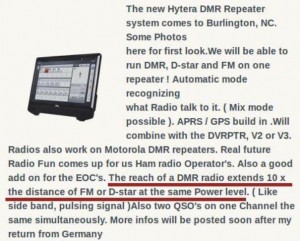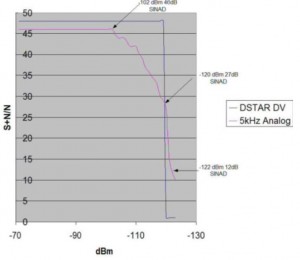Bron: DKARS magazine auteur Hans PD0AC
Before we dive into this subject: we’re not talking about digital modes on HF, but simplex communications on VHF and UHF. Popular digital modes currently in use are D-Star, DMR and dPMR. Obviously the use of repeaters and VoiP technology were ignored.
A lot of stories about the range advantages of both modes can be found on the Internet. Many of those stories fall in the category ‘anecdotal’ (conclusions based on one specific test), others in the category “We love to exaggerate”.
A nice example of the latter is the claim on the website of D-Star Radio Club International, which says “The reach of a DMR radio extends 10 x the distance of FM or D-Star at the same Power level.” Similar stories about the advantages of analogue can be found also.
 Measurements
Measurements
Mark Miller, N5RFX, wrote an interesting article which shows that the science behind this isn’t always that simple, nor straightforward. It all depends on what you want: noise-free communications for as long as possible, or maximum range, whatever the signal-to-noise ratio.
Even more important are the conditions under which both sta-tions are working – base to base, base to mobile, or – the worst case scenario – mobile to mobile.
Mark’s measurements don’t take any form of mobile use into account, else measurements would be impossible, but they will be valid for base to base com-munications.
FM receiver sensitivity
The sensitivity of an FM receiver is given as the power at the antenna needed to provide a 12 dB SINAD. SINAD pronounced by some as “sine add” and some as “sin add” is the ratio of the signal plus noise, and distortion over the noise, and distortion. When expressed in dB the ratio at sensitivity is 12 dB SINAD.
A signal generator is frequency modulated with a 1000 Hz tone (sometimes 1004 Hz) and the modulated R.F. is brought to the antenna port of the FM receiver.
The deviation is set for 3.3 kHz. The audio output from the FM receiver is brought to a device to measure SINAD. Sometimes this is a device called a SINADDER, distortion analyzer, or transmission impairment test set. The R.F. level is adjusted until the instrument measures 12 dB SINAD.
With digital signals SINAD is not a good measurement of sensitivity, because typically the SINAD of a digital receiver is quite high until a certain point where the audio signal disappears. There is no gradual falling off of the signal like there is with analogue signals. Figure 1 shows the results of sensitivity tests per-formed on an ID-800. The ID-800 in wide FM mode is intended for FM transmissions with a 3 to 5 kHz deviation. At the -102 dBm point the analogue FM receiver is at its highest SINAD. The 12 dB SINAD of this receiver occurs at –122 dBm. In Digital Voice mode (DV) the signal drops off at –120dBm.
This means that the analogue FM receiver is about 3 dB better in sensitivity than the DV receiver. 12dB SINAD signals are typically considered difficult copy. What we consider to be a full quieting FM signal is one where the SINAD is nearly 30 dB. The 27 dB SI-NAD point in Figure 1 occurs when the DV signal stops or is unin-telligible.
 DV advantage
DV advantage
The DV signal has a steady noise level to –119 dBm and drops off at –120 dBm. The analog FM signal SINAD begins to drop at –102 dBm. Between –102 and –119 dBm DV has a SINAD advantage over analogue FM. The advantage occurs over a 17 to 18 dB range. When noise free signals are desirable, DStar digital voice can meet this requirement with a 17dB to 18dB increase in the range that noise free operation can occur. For weak signal work, the analogue FM signal will prevail.
N5RFX’s conclusion:
Trading 2 dB of sensitivity for a 17dB increase in nearlynoise free reception is an advantage of D-Star over analogue FM. When weak signal reception is necessary, the analogue signal will provide better performance.
What seasoned users say
Hamradioscience.com: “My understanding of D-star range was that it was about the same as analogue FM (I would say that it is a little shorter because if you don’t get a good signal to the radio, the digital decoder can’t clearly decode the signal).”
KB9MWR: “Several Digital Voice operators have reported hands down, absolutely no question, tested it for months, that D-Star is usable for reliable (non-garbled communications) for mobiles about 10% or less of the coverage area of analogue FM, and for base stations about 80%. This is largely due to the picket fencing of a mobile signal, multipath for non line of sight, etc.
On a high peak in the desert with line of sight, one can imagine them being comparable, but not in the real world of trees and buildings.
Yaesu agrees in its System Fusion leaflet: “Analogue FM is effective when weak signal strength causes audio drop out in the digital mode, and enables communication up to the borderline of the noise level.
The above statements are in line with my experiences when using DMR: great signal to noise ratio, but up to a certain point. That point, often referred to as the ‘digital cliff’, means the end of a QSO. When I want to continue, I have no other choice than to switch back to analogue.
73 de Hans, PD0AC
Geef een reactie
Je moet ingelogd zijn op om een reactie te plaatsen.